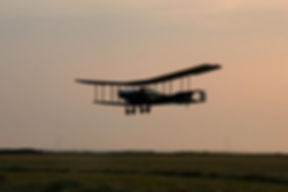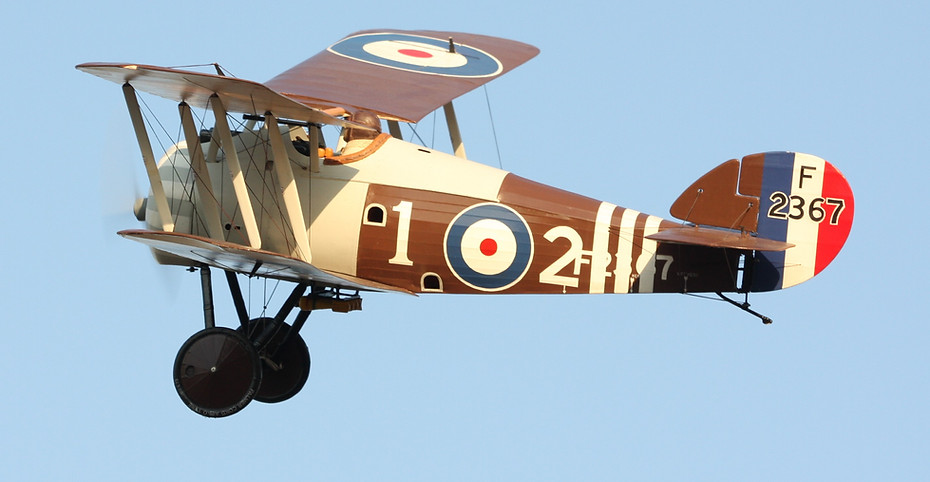
Sopwith Snipe

The real aeroplane based at Old Warden

For comparison, the model flying at the 2018 BMFA Nationals where it won the Super Scale Trophy.
Tell tales are, increased dihedral, compression screw on Mills engine, minor rigging details and big pilot.
The colour appears faded but this is due to camera exposures.
Photo by Andrew Boddington of Aeromodeller.
Sopwith Snipe for free flight scale competitions.
1/8th scale, 45" span and powered by an obligatory Mills 1.3 diesel.
I chose the reproduction Snipe that is kept at the Shuttleworth Collection at Old Warden.
I start with the tail feathers to get my head around the build as one has to be several steps ahead in the mind to minimise any "Oh Gosh" moments and then retro fitting.
Fairly standard build here. .8mm balsa core with 3mm squ ribs. The main spar of the tail plane has laminations of balsa and 4 fine strips (capping strips) of carbon for strength.
The unit is fitted to the fuselage with carbon tubes re-enforced with piano wire where the gap is between fin and tailplane.
Carbon tube leading edge and ali tube around the curves to create a fine edge.

Top wings are the same build as the bottom ones but with separate ailerons. The later Snipes had extended ailerons and a "round" rudder.
Wings weigh 32 grms each

The basic box is made from 3mm spruce and balsa with a 6mm lite-ply bulkhead. The stringers are 1.5mm cedar, much stronger than balsa, to prevent "starved horse" shrinkage.
The tricky bit was making the cowling. I usually find an ali' teapot to butcher, but decided to go the whole hog and bash one out from scratch.
A friend of mine turned the former from a monster steel pipe. Very heavy. To this I clamped a piece of 1.5mm annealed aluminium and set to work with a planishing hammer. It went all horrid and wrinkly, I persisted with it and what seemed to me to be thousands of pings later, it has not come out too bad. I had to anneal it several times to keep it supple. The cowl was then slowly "smoothed" with the flat of the hammer. Lots of wet and dry sanding to finish. Took about 4 hours altogether.
The wheels are laminated layers of balsa and ply with a brass axle tube. This was roughly shaped and then turned and sanded on a drill.
The "spokes" are thin thread wound around the wheel and adhered with aliphatic glue. The outside face was then covered with silk and doped several times.
Axle and bungee pegs will be trimmed after the lime wood legs and spreader bar are fitted.

First "full" fit together. All seems to line up ok but I did have a lot of bother getting the angle of the dangle of the piano wire cabane struts right. I made two rears and three fronts Before I was happy.
You will notice the colour tests on the wheels are a "shade of chocolate".

Spent a lot of time fitting out the cockpit interior before adding the streamlining stingers and sheeting to the outside of the fuselage.
Seat is printed paper over balsa. The instruments and fittings are made from whatever was available from a good rummage in the bits and bobs box.

All put together now and ready for covering. Will leave it for a week before I do.

A silk over tissue covering was used as described under Tech Tips page. Strong and light with a good surface texture to paint onto. Rib tapes have also been added.

Bentley B2 engine was made using a combination of balsa and plywood. The cooling fins are fuse-wire wrapped around the balsa cylinders. Push rods are carbon tubes. Exhaust pipes bendy straws. A handful of 10BA nuts and a spray of Spectrum silver finishes the job. The missing cylinder is replaced by the Mills engine. The tricky bit was cutting away the reverse side to ensure the Mills engine would fit and run properly.


The paint job on the top surfaces is done with Humbrol enamels. The under side was coloured using Ford ivory from a spray can

The finished model after it was given two coats of fuel proofer to reproduce the correct surface texture.
The model proved quite difficult to trim and make it a consistent and realistic flying model. I ended up with the cowling holding 8ozs of lead and the engine down thrust at 12 degrees to get it to behave. I do not doubt that flights will remain "interesting"
After a protracted 18 month trimming session I was fortunate enough to win the Super Scale Trophy at the British Nationals 2018.
See video attached for the winning Snipe flight.
By kind permission of Chris Brainwood
Or go to youtube for Free Flight Scale at the BMFA Nationals 2018
A selection of various model flights with my Sopwith Snipe being the last flight.
https://youtu.be/L9JkTSzG-SA?list=PLdYkPqNtvvHQRzS4R__d6uL-JnKnw-0gS